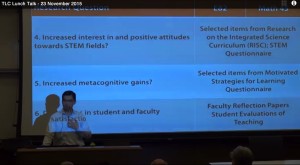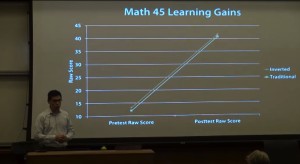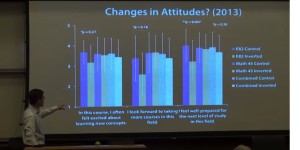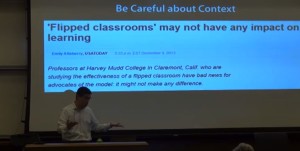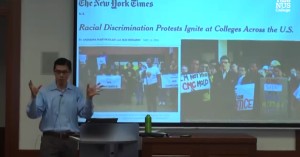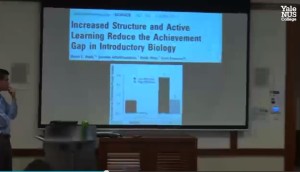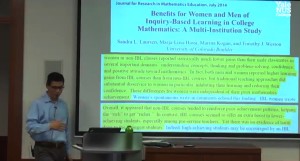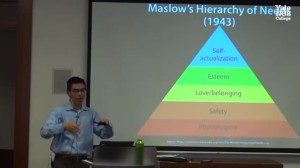Toward the end of the Semester, our CTL invited Darryl Yong from Harvey Mudd College to visit Yale-NUS. Darryl is an old friend from Claremont, and his work as an Associate Dean, Diversity Officer, and irrepressible Math teacher has been an inspiration for me. Darryl spent a year of sabbatical teaching math in an inner city Los Angeles Public School, and has conducted a rigorously controlled study of flipped classrooms, among other things. His two talks for us at Yale-NUS College were “Flip++” – a discussion of how to optimize the flipped classroom environment, and “Is Inclusive Teaching the Same as Good Teaching?” Darryl also met with several of our faculty and had a number of great discussions about teaching, technology and creating an inclusive and interdependent classroom.
The first talk discussed “Why Flip?” and listed some benefits of flipping – more content, more student engagement, deeper learning, and more classroom community. Darryl also pointed out that the research is showing that lecturing is definitely invalidated as a teaching approach. He cited an article which mentioned that for further educational research studies, lecture would no longer be considered a comparison, as it has been shown to have such lower learning gains.
Darryl’s work provided a “Quasi-Experimental Study” of the flipped environment, and was a tightly controlled experiment in which three instructors gave exactly the same materials both in the flipped and traditional classrooms. The three instructors included two math professors and an engineering professor. Students would watch online lectures in the flipped format and work homework problems in class. Homework was designed to be authentic engineering challenges in the engineering class, to provide a richer experience for the “synchronous” time in the flipped format. The “traditional” students would do exactly the same exercises, and watch exactly the same lecture in the opposite order, with the synchronous component of the class given to short lectures with questions.
Already you can see that the “traditional” part of the experiment is hardly a traditional lecture; the instructors worked closely together to craft a compelling and interactive class for both groups of students. Likewise the “flipped” group was not doing what typically happens in a flipped class – the requirement for a controlled experiment meant that the class time was not optimized for active learning but instead was required to work the same homework problems as the “traditional” group.
Darryl Yong and Nancy Lappe found statistical differences in learning gains between the two groups. This is not to say there is no benefit from flipped classes, but instead that the flipped format alone will not provide gains in learning. Below are some figures from Darryl’s talk – giving examples of different learning gains from the two groups, and the response by students to students to the “affective” component of the class experience. The headline of “Flipped classrooms may not have any impact on learning” comes from USA Today, but oversimplifies the conclusions of Darryl’s study.
Darryl also gave a wonderful talk on Inclusive Teaching and Diversity, entitled, “Is Inclusive Teaching the Same as Good Teaching?” This talk was very timely given the nature of the debate in the U.S. about diversity. Our Yale-NUS College has a wonderful form of diversity all its own – hosting students from over 40 nations together with a mix of cultures from across the earth, representing all the major religions and language groups, in which Singaporeans comprise about 60% of the students, and other nations in blocks of 5-10% from the US, India, various European countries, Australia, Malaysia, Korea, New Zealand and several African nations.
Within the US, Darryl mentioned that there is a wide diversity of experience in students who come to study math and engineering subjects. He showed a wide range of percentage degrees awarded to women students in STEM fields. Darryl points out that “even if you bring a group of relatively diverse people together in a space, that does not magically make the problems go away.. the question of diversity hinges on a broad representation of people as the starting point. That is step one of the process. Once the people have been assembled together, then the hard work begins.” He then discussed how experiences within classrooms vary for different groups of students. He also showed educational research results that gives data to support the idea that “increased structure and active learning reduces the achievement gap in introductory biology.” (A study by Haak, HilleRisLambers, Pitre, and Freeman, Science, 2011). He also showed how Inquiry-based learning in college mathematics helped women to learn better (Laursen, Hassi, Kogan, and Weston, Journal for Research in Mathematics Education, 2014).
One of the key parts of the talk was Darryl’s reinterpretation of Maslow’s Hierarchy of Needs (1943). The pyramid of needs includes urgent and base needs (Physiological, Safety, Love/Belonging), then higher needs like Esteem and Self-Actualization. He pointed out that unless the needs from the lower levels are met, you can’t begin to access the higher levels of need. Darryl cleverly applied this hierarchy to classrooms. In this context the needs become slightly different. Generally physiological needs are met (air conditioning, etc in Singapore!). However some students are feeling stress from family situations which can block their ability to learn – financial problems at home, other crises can bring physiological stress to prevent learning. Awareness of the diversity of student life circumstances can help our students learn. The Safety level can be interpreted as “emotional safety” – students need to feel that they will not be ridiculed and humiliated in classes. “Safe Spaces” – so popular in the US – is referring not to a need from students in the US to be physically safe or coddled, but instead to have a place where students feel understood and free from aggressions. Darryl points out both obvious and subtle forms of humiliation that students can feel in classes. The students really need to know they will not be made fun of for lack of knowledge, and if they do they will be prevented from learning or continuing. Even a professor using in a talk to students “it is obvious” can provide a sense of inadequacy in students, and block further learning. Addressing student questions with respect and kindness is crucial for helping the students along.
The other thing Darryl point out is that a classroom needs to build a sense of belonging, which can be built into a classroom. By bringing students together in collaborative projects, and setting up a classroom culture that fosters interdependence among the students, they are able to learn better. Darryl notes that we can actually underestimate the power of student connections in classrooms – and learning names of students – can have more of an impact than we realize. Other methods of fostering belonging include humor, and welcoming attitudes within the class. He cited a professor who even gave students an initial handshake when they came into a class, which a study showed increased the sense of belonging in the students.


